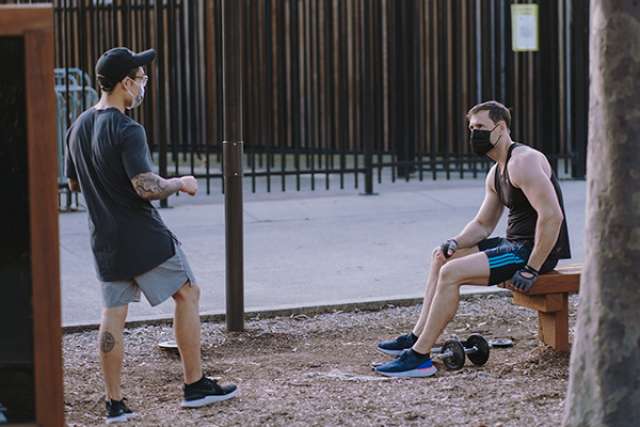If physical distancing measures in the United States are relaxed while there is still no COVID-19 vaccine or treatment and while personal protective equipment remains in short supply, the number of resulting infections could be about the same as if distancing had never been implemented to begin with, according to a UCLA-led team of mathematicians and scientists.
The researchers compared the results of three related mathematical models of disease transmission that they used to analyze data emerging from local and national governments, including one that measures the dynamic reproduction number — the average number of susceptible people infected by one previously infected person. The models all highlight the dangers of relaxing public health measures too soon.
"Distancing efforts that appear to have succeeded in the short term may have little impact on the total number of infections expected over the course of the pandemic," said lead author Andrea Bertozzi, a distinguished professor of mathematics who holds UCLA's Betsy Wood Knapp Chair for Innovation and Creativity. "Our mathematical models demonstrate that relaxing these measures in the absence of pharmaceutical interventions may allow the pandemic to reemerge. It's about reducing contact with other people, and this can be done with PPE as well as distancing."
The study is published in the journal Proceedings of the National Academy of Sciences and is applicable to both future spikes of COVID-19 and future pandemics, the researchers say.
If distancing and shelter-in-place measures had not been taken in March and April, it is very likely the number of people infected in California, New York and elsewhere would have been dramatically higher, posing a severe burden on hospitals, Bertozzi said. But the total number of infections predicted if these precautions end too soon is similar to the number that would be expected over the course of the pandemic without such measures, she said. In other words, short-term distancing can slow the spread of the disease but may not result in fewer people becoming infected.
Mathematically modeling and forecasting the spread of COVID-19 are critical for effective public health policy, but wide differences in precautionary approaches across the country have made it a challenge, said Bertozzi, who is also a distinguished professor of mechanical and aerospace engineering. Social distancing and wearing face masks reduce the spread of COVID-19, but people in many states are not following distancing guidelines and are not wearing masks — and the number of infections continues to rise.
What are the implications of these findings for policymakers who want to relax social distancing in an effort to revive their economies?
"Policymakers need to be careful," Bertozzi said. "Our study predicts a surge in cases in California after distancing measures are relaxed. Alternative strategies exist that would allow the economy to ramp up without substantial new infections. Those strategies all involve significant use of PPE and increased testing"
During the 1918 influenza pandemic, social distancing was first enforced and then relaxed in some areas. Bertozzi points to a study published in Proceedings of the National Academy of Sciences in 2007 that looked at several American cities during that pandemic where a second wave of infections occurred after public health measures were removed too early.
That study found that the timing of public health interventions had a profound influence on the pattern of the second wave of the 1918 pandemic in different cities. Cities that had introduced measures early in the pandemic achieved significant reductions in overall mortality. Larger reductions in peak mortality were achieved by those cities that extended the public health measures for longer. San Francisco, St. Louis, Milwaukee and Kansas City, for instance, had the most effective interventions, reducing transmission rates by 30% to 50%.
"Researchers Martin Bootsma and Neil Ferguson were able to analyze the effectiveness of distancing measures by comparing the data against an estimate for what might have happened had distancing measures not been introduced," Bertozzi said of the 2007 study. "They considered data from the full pandemic, while we addressed the question of fitting models to early-time data for this pandemic. During the 1918 influenza pandemic, the early relaxation of social distancing measures led to a swift uptick in deaths in some U.S. cities. Our mathematical models help to explain why this effect might occur today."
The COVID-19 data in the new study are from April 1, 2020, and are publicly available. The study is aimed at scientists who are not experts in epidemiology.
"Epidemiologists are in high demand during a pandemic, and public health officials from local jurisdictions may have a need for help interpreting data," Bertozzi said. "Scientists with relevant background can be tapped to assist these people."
Study co-authors are Elisa Franco, a UCLA associate professor of mechanical and aerospace engineering and bioengineering; George Mohler, an associate professor of computer and information science at Indiana University – Purdue University Indianapolis; Martin Short, an associate professor of mathematics at Georgia Tech; and Daniel Sledge, an associate professor of political science at the University of Texas at Arlington.



